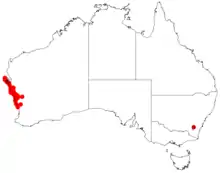Acacia idiomorpha
Acacia idiomorpha is a shrub belonging to the genus Acacia and the subgenus Phyllodineae that is endemic to a small area of western Australia.
| Acacia idiomorpha | |
|---|---|
| Scientific classification | |
| Kingdom: | Plantae |
| Clade: | Tracheophytes |
| Clade: | Angiosperms |
| Clade: | Eudicots |
| Clade: | Rosids |
| Order: | Fabales |
| Family: | Fabaceae |
| Clade: | Mimosoideae |
| Genus: | Acacia |
| Species: | A. idiomorpha |
| Binomial name | |
| Acacia idiomorpha | |
 | |
| Occurrence data from AVH | |
Description
The spreading spinescent shrub typically grows to a height of 0.2 to 1.0 metre (0.7 to 3.3 ft) and has a sprawling habit.[1] It has branchlets covered in soft hairs or can be glabrous and 2 to 7 mm (0.079 to 0.276 in) long straight or slightly curved stipules. Like most species of Acacia it has phyllodes rather than true leaves. The undulate and pungent phyllodes have an asymmetrically ovate to narrowly ovate shape but can be elliptic or narrowly oblong-elliptic. They can be 5 to 25 mm (0.20 to 0.98 in) in length and 3 to 14 mm (0.12 to 0.55 in) wide and have one prominent nerve with obscure lateral nerves.[2] It produces yellow flowers from July to August.[1] The simple inflorescences occur singly or in pairs in the axils and have spherical to slightly obloid flower-heads that contain 40 to 100 golden flowers and have a diameter of 5 to 8 mm (0.20 to 0.31 in). The seed pods that form after flowering have a narrowly oblong shape and are usually curved. The undulate and hairy pods have a length of up to 6 cm (2.4 in) and a width of 4 to 5 mm (0.16 to 0.20 in). The mottled light grey to brown coloured seeds inside have an oblong to widely ovate or elliptic shape with a length of around 3 mm (0.12 in) and a subterminal aril.[2]
Distribution
It is native to an area along the west coast in the Wheatbelt and Mid West regions of Western Australia situated on near-coastal cliffs and dunes growing in sandy or loamy soils usually over or around limestone or sandstone.[1] The range of the plants extends along the coast from around Ledge Point in the south up to Tamala Station and Dirk Hartog Island in Shark Bay in the north. It is often part of mallee groves or shrubland communities.[2]
See also
References
- "Acacia idiomorpha". FloraBase. Western Australian Government Department of Parks and Wildlife.
- "Acacia idiomorpha". World Wide Wattle. CSIRO publishing. Retrieved 14 June 2020.